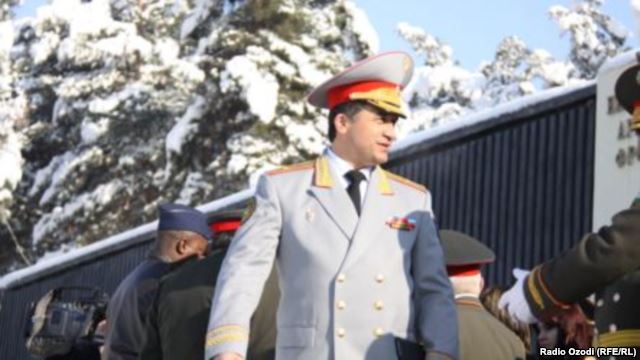
Threatened From Afghanistan, Central Asia May Win the Battle Only to Lose the War
Publication: Eurasia Daily Monitor Volume: 12 Issue: 161
By:

Dual armed attacks shook Tajikistan, on the night of September 4, as militants allegedly connected to former deputy defense minister General Abduhalim Nazarzoda fired on a police station and a weapons depot in and around Dushanbe. The resulting firefights with government forces ended with 22 dead and 14 arrests; Nazarzoda, who has been accused by the government of having links with the recently banned Islamic Revival Party of Tajikistan (IRPT) and was ousted following the September 4 attacks, remains at large (Centrasia.ru, September 9). As the past week’s events in Tajikistan show, the countries of Central Asia—which are confronted with an Islamist threat from Afghanistan—may win the battle at the border only to lose the war everywhere else. The reason for that is simple: as weak as the security arms of these countries are, they are in many cases quite capable of repelling a violent cross-border attack from the various Islamist groups in Afghanistan; but as strong as their military and internal security police may be, they are unlikely to escape the ideological influence and internal subversion that their own governments have created by their clumsily repressive approaches to Islamic groups.
Unfortunately, that distinction is being lost in many discussions of the problem. A recent article in the Rex Information Agency is typical: It focuses on the capacity of the armed forces of Turkmenistan to deal with militant groups that represent the chief bearers of the Islamist threat to that country from abroad (Iarex.ru, August 31). The article concludes that Ashgabat, despite weaknesses in its security sector, can beat back almost any conceivable Islamist band that might attack over the border. Such a conclusion reflects the Maginot Line–type of thinking of those who assume that the regional security services can cope with any challenge.
In fact, as the events in Tajikistan and elsewhere over the last several weeks show, such thinking is completely misplaced for three sets of reasons. First, the Islamist threat is an ideological rather than primarily a military one, at least at present. Second, the borders between Afghanistan and these states, as well as between the Central Asian republics themselves, resemble “frontiers” more than actual “dividing lines.” In fact, the same ethnic or religious groups often liven on both sides of these borders. And third, and by far the most important, the governments in Central Asia have often behaved in ways that have promoted the spread of Islamist values rather than countered them in an effective way.
As the best Russian and Western specialists on the Islamist threat have long maintained, the Islamic State organization and related groups are, first and foremost, an ideological threat to existing states. These extremist organizations recruit supporters from within the populations of various countries and sometimes even from within the senior ranks of the security services and the military; these groups’ success comes from the values they espouse rather than because of their military prowess. They may achieve less by military victory than by conversation, but the defeats they suffer in the military area do not necessarily have an impact on their attractiveness. Indeed—and this is something that must never be forgotten—each military defeat the Islamic State and other Islamist groups may suffer has the effect of producing martyrs who, in death, are often more powerful than they were in life. Consequently, defining the task of defeating them in strictly military terms is not only counterproductive but a path to ultimate defeat.
This is especially so in Central Asia, where the lines on maps look so significant from afar. In actuality, however, not a single border between these countries or between them and Afghanistan resembles borders like those in Europe. Instead, they are frontiers, with members of the same ethnic and religious groups straddling them on both sides—a situation that precludes the shutting down of communication across them. Even in Soviet times, Islamic groups in Iran and elsewhere were able to send propaganda into Central Asia. The border was far more porous than in Europe, and it remains so. The post-Soviet governments have not been able to change that.
But what makes the situation so dangerous is that the governments in Central Asia have, on many occasions, been rather clumsy in dealing with Islamic groups. A number of such groups have been outlawed, such as Dushanbe’s recent ban of the Islamic Revival Party of Tajikistan, which only sends them underground; in other cases, all opposition factions have been treated as “Islamist,” as Tashkent often does in the hopes of avoiding criticism from the West for the suppression of civil society. The result is that among the populations of Central Asian countries, Islamists are not viewed as isolated from the opposition, as they might be if a vibrant civil society existed. Rather, these Islamist groups are increasingly viewed as the most consistent expressions of the quest for justice, which animates many of the people there.
Consequently, in the coming weeks, Central Asian governments will likely be able to again report that they have successfully countered this or that Islamist challenge from militants in northern Afghanistan. And of course, such reports will be welcomed by both Moscow and the West as evidence that religious extremism is being contained. But as these governments count their victories in border skirmishes, they are likely to be losing the war to the Islamists, who are gaining ground throughout the region as opponents of authoritarian rule. Increasingly, it may be too late for these governments to eke out a real victory over the Islamists: they have perhaps become their own grave diggers.




